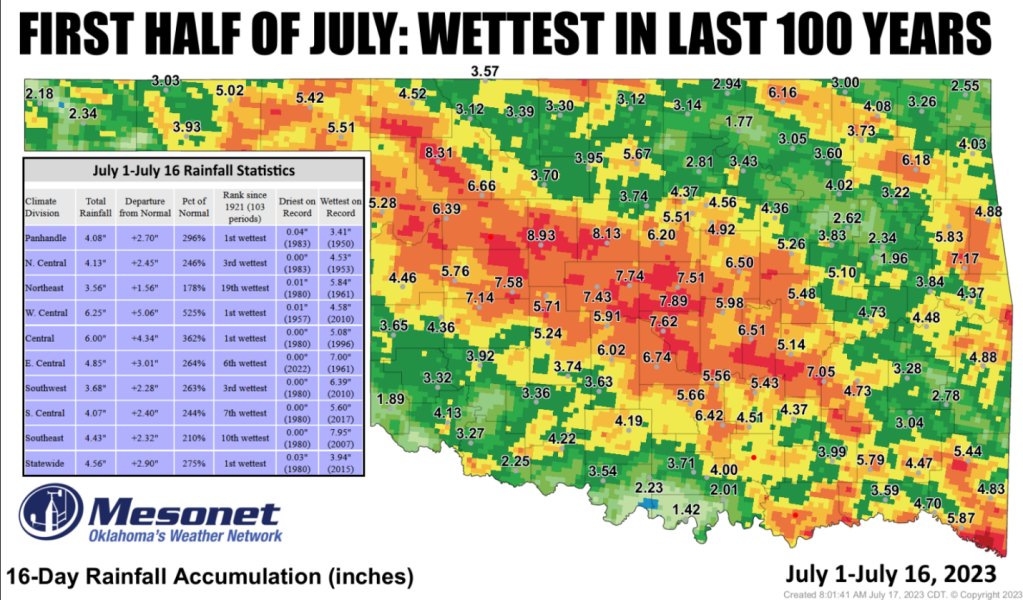The general narrative of climate change is that when it comes to the weather, there is no normal anymore. Well, if that is the case, 2023 is playing right to script. This definitely has been the summer of weather surprises.
The hottest June on record has been followed by an early July that has included what’s being reported as the 10 of the hottest days in history. Heat waves are simultaneously suffocating the US, much of Europe and parts of Asia and the waters off of Florida hit an unprecedented 90oF. Take all this and throw in what looks more and more like a powerful El Niño coming our way later in the year and it becomes clear that 2023 seems to be on the path to becoming the warmest year since ever (at least since record-keeping began in the 1800s).
A little closer to home we have been getting some rather unusual (and generally welcome) rain—in fact, according to the Oklahoma Mesonet this is the most moisture Oklahoma has gotten in July over the last 100 years—

This obviously is not typical for this time of year. It is welcome, but definitely out of the ordinary.
Our friends in the upper Midwest have also been getting rain-something desperately needed in the corn belt. Before this latest bit of moisture however, the situation was getting dire. One news source reported that the region went into the summer with an unusually low amount of soil moisture. One extension educator with the University of Nebraska stated that they had never seen a year when the farmers in their state had started planting corn with such a low amount of subsoil moisture. They were quoted as saying that “Even in the 2012 drought we had a bit of a head start with some subsoil moisture. This year is at a whole other level because we didn’t have that.”
Doug Kluck, a climatologist with the National Oceanic and Atmospheric Administration (NOAA) said that May and June, a time when the region normally gets around 60% of their precipitation, was incredibly dry.
“When you miss precipitation during those two months, you know there’s going to be trouble,” NOAA’s Kluck said. “We didn’t have that moisture to bank for later in the summer when things typically get even drier.”
Luckily the trend changed—at least for now. One producer was quoted as saying “The turnaround is magical but we need more rain, that’s for sure. We are by far not out of the woods. Another dry week and we’re right back where we were.”
Meanwhile in Texas the National Weather Service has issued a series of Extreme Heat Warnings across the state as temperatures again skyrocket. “Beginning Monday (July 17), dangerous heat will build in the Gulf Coast and Southeast U.S. again, with widespread heat index readings over 110 degrees through Friday, before refocusing in the Southwest and western U.S. next weekend and beyond,” the warning from the forecasters said. The weather service goes on to say that heat levels could break records across the Southwest.
All this adds up to just more examples of the rollercoaster ride we are on when it comes to weather. In risk of sounding like a broken record, I again want to implore agriculture producers to consider what they can do to harden their operations to extreme weather. Please take advantage of the record assistance available through programs like EQIP and CSP. You can find more information about these programs and other assistance at your local USDA Service Center.
The crazy weather is just going to get crazier.